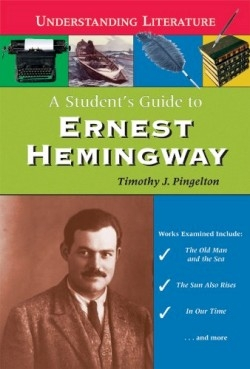A Student's Guide to Ernest Hemingway
To a generation pounded by the sounds of heavy metal, and bombarded by nothing-left-to-the-imagination images on the screen, the works of American literary icons from the past must seem pretty tame. Ernest Hemingway and other writers of the Lost Generation, however, had much to say about war, peace, honor, and love—relevant topics for today’s teens.
This guide, part of the “Understanding Literature Series,” helps pique young adult readers’ interest in Hemingway as the book shows how his life experiences influenced his novels, stories, and poetry, and explains essential literary terms.
The guide also is a roadmap to good writing. It explains how Hemingway adopted his personal style and his philosophy of writing, and gives examples of some of his powerfully simple prose. Hemingway is known for his short, journalistic sentences—a style he learned as newspaper reporter.
Writers are counseled to write about what they know; Hemingway used his experiences to good advantage. A handsome womanizer (married four times), a partyer and traveler, he witnessed the horrors of three wars, as well as the excitement of bullfights. These experiences often figure in his literary works.
Hemingway was also part of the modernism school that replaced the Victorian romantics. According to the author’s explanation of modernism, “All endings don’t have to be happy ones where all problems are solved; not all heroes have to be perfect in every way; not all good people are rewarded; and not all bad people are punished.”
Pingelton expertly weaves key parts of Hemingway’s biography with sections discussing some of his most famous works (The Old Man and the Sea; The Sun Also Rises; In Our Time; and For Whom the Bell Tolls), which are likely to be part of a school curriculum. He is realistic about Hemingway’s personal problems with alcohol and his eventual suicide. Winner of the Nobel and Pulitzer prizes, Hemingway met a tragic end that ironically reflected “modernism.”
Pingelton, author of stories and articles, brings his high school and college teaching experience to bear in this guide. Explanations are clear, examples abound, and there is enough repetition to reinforce the author’s points. His guide is clear, complete, and illustrated with wonderful photographs from Hemingway’s life.
More consistency in numbers and numerals, and a more complete index would have improved the book; but that said, the author successively brings Hemingway to life to life for either classroom or personal use.
Reviewed by
Linda Salisbury
Disclosure: This article is not an endorsement, but a review. The publisher of this book provided free copies of the book to have their book reviewed by a professional reviewer. No fee was paid by the publisher for this review. Foreword Reviews only recommends books that we love. Foreword Magazine, Inc. is disclosing this in accordance with the Federal Trade Commission’s 16 CFR, Part 255.

